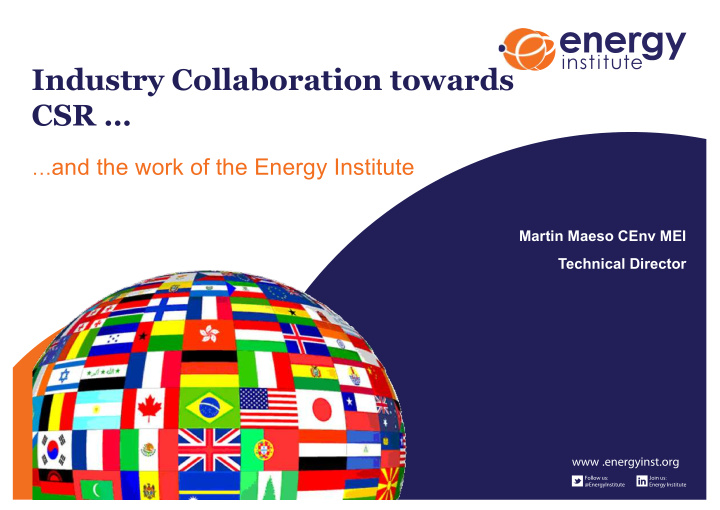



Industry Collaboration towards CSR … … and the work of the Energy Institute Martin Maeso CEnv MEI Technical Director
One definition of Corporate social responsibility is… …a form of corporate self regulation, where a business monitors and ensures its active compliance with the spirit of the law, ethical standards and national and international norms. www.energyinst.org
The EI Technical Work Programme …securing a successful future… how the solution of Good Practice Guidance works Together the industry is effective & Business can thrive Separately disconnect & risk of failure gets progressively higher until faced with a massive challenge Successfully Addressing Corporate Risk through Good Practice Guidance Adapted from McCredie & Weijermars, Risk Management for Sustainable Profits , Pet Rev, October 2012
We have USP = we offer something different… We are NOT a Trade Learned society Association Consensus Professional membership organisation Collaboration Developer of industry good practice Honest One roof broker Broad Church User community is driving the Cross sectoral development of good practice Old and new
Setting the right culture is key…and that starts at the top, • Guidance aimed at senior leaders, including Board members • Provides fairly short chapters on a number of topics, with the aim of improving decision making: • Safety culture and safety leadership • Cognitive and social biases • Board competences • Understanding safety performance data – what it does and doesn’t tell you about process safety • Setting the ‘appetite for risk’ • Budget setting – avoiding the unintended consequences 31/01/2018 4
What makes a good leader… “Walks the talk” – Acts as role model. Shows personal interest. “Stays informed” – proactively seeks to understand organisations culture. “Promotes trust and accountability” – trusts, and is trusted by, the workforce to do the right thing. Prioritises safety/environment over other considerations - Safety always number one consideration, even if means stopping operations. CSR culture needs to be set from the top of any organisation. Not just a hollow policy statement that is not enacted on site. 31/01/2018 5
Competencies for Board members • Safety Knowledge • Problem solving • Social competence • Can they avoid group think • Understand the information that they need in order to make decisions. 31/01/2018 6
Some examples of good practice guidance towards happy healthy workers and a protected environment We know there is a strong business case from independent audit by EY. ROI of between 35:1 and around 140:1 …the power of collaboration Some examples……..
Human and organisational factors professional development: complete training resource • Intended as a complete ‘off the shelf’ human factors training course solution • 5 modules, to be run over 4-5 days • Trainer guide, with: • Syllabus • Lesson plans • References • Exam answers • CD ROM with: • Power Points slides (400+) • Student packs • Exercises • Exam • ‘Just add trainer’ https://www.energyinst.org/technic al/human-and-organisational- factors/complete-training-resource
Learning from incidents, accidents and events • Based on literature and 3 stakeholder workshops; 50+ individuals involved, each with 10-20 years experience = many years knowledge captured in one document. • Provides current good practice guidance on improving all aspects of learning from incidents, with a focus on learning. • Guidance • Blockers & enablers • Case studies • Aims to be the initial ‘go to’ guide for LFI 9
Protecting workers in extreme environments The influence of climatic factors on work performance in the oil and gas industry – The energy industry operates in a wide range of environmental conditions across the globe. This report gives guidance on the impact of these conditions on worker safety, health and performance (and hence productivity), and in localised man-made environments such as machinery spaces and other work spaces where heat and humidity can be particular problems.
Monitoring health of workforce longer term An investigation of mortality and cancer incidence in United Kingdom oil refinery and petroleum distribution workers 1951-2011 – This third edition of the two reports detail an analysis of the mortality and cancer morbidity experienced by a cohort of 28,554 oil refinery workers as well as by a cohort of 16,467 petroleum distribution workers for the period 1951-2011
What do we expect of the workforce – fitness requirements The physical demands of sea survival training – This report describes a research study to consider the physical demands of this training and the success rate of those completing it. The observations on each of the essential tasks (entering life raft; towing a casualty; helicopter underwater escape training (HUET), and EBS training) are presented and conclusions drawn on the adequacy of training provision V
International remit • The EI is a global organisation: • Guidance used in 90+ countries • 30% of Technical Committee members from outside UK • EI branches located in: • Nigeria • Singapore • Malaysia • Abu Dhabi
Demonstrating Professionalism across the Worlds Energy Industry - Working together • Innogy • Shell • Apache • Kuwait Petroleum • SSE • Aramco • Maersk • Statoil • BP • Nexen CNOOC • Tesoro • Centrica • Orsted • Taqa • Chevron • Phillips66 • Total • ConocoPhillips • Petroineos • Tullow Oil • DCC • Perenco • Valero • E.ON • Uniper • Vitol Energy • EDF Energy • Qatar Petroleum • Vattenfall • ENI • Repsol Sinopec • Woodside Energy • Engie • RWE • World Fuel Services • Essar • Scottish Power • ExxonMobil • SGS www.energyinst.org
Professionalism & the Global Energy Industry: “ In the long history of humankind (and animal kind, too) those who learned to collaborate and improvise most effectively have prevailed ” Charles Darwin www.energyinst.org
Recommend
More recommend